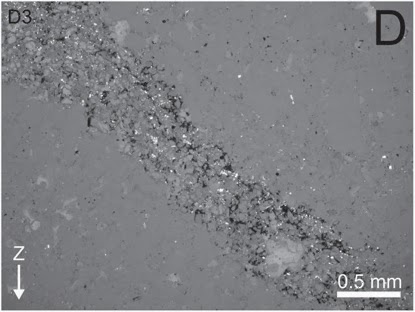Styolites are pressure structures formed in limestones under
stress. They tend to form thin layers which can continue laterally for great
distances, forming planar layers along which the limestone has been recrystallized,
apparently as a result of pressure-liquefaction, and which is thought to be
denser than the surrounding matrix. These styolite layers have generally been
assumed to present a barrier to fluid flow (i.e. the movement of liquids or
gasses through the limestone), though this has never actually been tested
experimentally.
In a paper published in the journal Geology in January 2014,
Michael Heap, Patrick Baud and Thierry Reuschlé of the École et Observatoire des Sciences de la Terre at the Université de Strasbourg and Philip Meredith of the Department of Earth Sciences at University College London describe
the results of a series of experiments on segments of limestone from boreholes
from the Jurassic Oxfordian and Dogger Limestones, to evaluate whether the
presence of styolites did in fact reduce the permeability of the limestone.
Styolite layer in a borehole section from the Dogger Limestone. Heap et al. (2014).
Heap et al. found no evidence that the
styolites did in fact present a barrier to fluid flow, in fact in some of the
samples the presence of styolites appeared to facilitate an increased rate of
fluid flow within the limestone. Examination of the styolites using CT Scanning
suggested that only the thinnest styolite layers appeared to be denser than the
surrounding matrix, with thicker styolite layers being significantly less dense
than the matrix, and therefore more permeable to fluid flow. While the thinnest
layers were denser than the matrix, and therefore could potentially have
presented a barrier to fluid flow, these very thin layers were not constant in
thickness, and in places thinned to a zero thickness (i.e. they were patchy,
and had gaps), so that they did not present an impenetrable barrier to fluid
flow.
See also Exploration company claims to have struck oil off Lagos State, Nigeria, The British Geological Survey reports on Shale Gasses in the Bowland-Hodder Unit, Substantial new aquifer found under northern Namibia, Mapping Africa's groundwater resources and Gas hydrate pingoes in the Kwanza Basin off the coast of Angola.
Follow Sciency Thoughts on Facebook.

